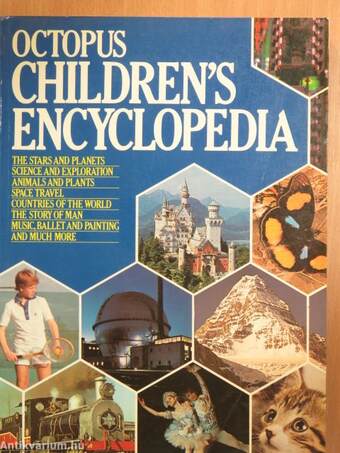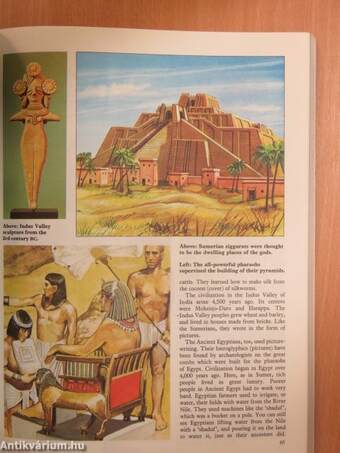1.067.081
kiadvánnyal nyújtjuk Magyarország legnagyobb antikvár könyv-kínálatát

VISSZA
A TETEJÉRE
JAVASLATOKÉszre-
vételek
Octopus Children's Encyclopedia
The stars and planets, science and exploration, animals and plants, space travel, countries of the world, the story of man, music, ballet and painting and much more
| Kiadó: | Octopus Books Ltd. |
|---|---|
| Kiadás helye: | London |
| Kiadás éve: | |
| Kötés típusa: | Fűzött papírkötés |
| Oldalszám: | 224 oldal |
| Sorozatcím: | |
| Kötetszám: | |
| Nyelv: | Angol |
| Méret: | 28 cm x 21 cm |
| ISBN: | 0-7064-1816-6 |
| Megjegyzés: | Színes fotókkal és illusztrációkkal. |
naponta értesítjük a beérkező friss
kiadványokról
naponta értesítjük a beérkező friss
kiadványokról
Előszó
THE UNIVERSE
The universe stretches as far as the most powerful telescopes can see—and farther. It contains countless millions of galaxies, and each galaxy contains countless millions of stars.... Tovább
Előszó
THE UNIVERSE
The universe stretches as far as the most powerful telescopes can see—and farther. It contains countless millions of galaxies, and each galaxy contains countless millions of stars. Our Sun is just one of these stars.
Studying the Heavens
People who study the heavens are called astronomers. They p'ractise the science of astronomy. Astronomy is alsó a popular hobby. Thousands of amateur astronomers, young and old, enjoy gazing at the night skies with simple telescopes or through binoculars.
Early Astronomers
Astronomy is perhaps the oldest science of all. The Chaideans and the Babylonians were skilled observers of the heavens
Below right: Somé telescopes use curved mirrors to gather light rays. They are called reflectors. Others, called refractors, use lenses. The diagram shows how a refractor works. It has two sets of lenses held in a tube. The object lens collects the light. The eye-piece lens can be moved in and out for focusing.
Below and left: Astronomers pass starlight through a prism in an instrument called a spectroscope. The prism splits the starlight into a spectrum, or band of colour crossed by dark lines. These teli them many things, such as how hot the star is. Sirius, for example, is a hotter star than the Sun.
Spectrum of the star Sirius
Words Used in Astronomy
eclipse The partial or complete 'hiding' of one heavenly body by another.
galaxy A large group of stars.
light-year A unit of distance used in astronomy. It is the distance travelled by light in one year—9.5 millión millión kilometres (5.9 millión millión miles).
moon A natural body that orbits a planet.
orbit The path of one heavenly body as it travels round another.
satellite Any body—natural or man-made—that orbits a heavenly body.
solar system A star and its satellites.
star A heavenly body that produces its own heat and light. Our Sun is a star.
universe Everything that exists. The universe appears to be expanding like a balloon being blown up.
Object lens
Focusing adjustment Vissza
Tartalom
Contents
The Universe 6
Studying the Heavens 6
Stars and Galaxies 8
The Life-giving Sun 10
The Solar System 12
TheMoon 14
TheEarthló
The Earth's Structure 16
Surface Features 18
Rocks 20
Seas, Lakes, Rivers 2 2
Weather and Climate 24
TheChangingYear 26
Plánt World 28
The Plánt Kingdom 2 8
Fungi 30
Conifers 32
Flowering Plants 34
PlantsandMan 36
Animál World 38
The Animál Kingdom 3 8
Prehistoric Animals 40
Fishes 44
Amphibians and Reptiles 46
Mammals 48
Birds
How Birds Live Nesting Migration Insects and Spiders Animals as Pets
History ofMan 62
Time chart
Early Man and the First Civilizations Ancient Greece The Román Empire Civilizations of Asia and Aírica Civilizations of America
TheMiddleAges 74
The Renaissance and Reformatión 7 6
The Industrial Re volution 7 8
GreatRevolutions 80
The World Wars 82
The World Today 84
Flagsofthe World 86
Continents and Countries 88
Asia 88
Europe 94
Africa 100
N orth America 106
South America 112
Australasia 114
PolarRegions 116
Exploration andDiscovery 118
Early Explorers 119
The Great Age ofExploration 120
Polar Exploration 122
Exploration Today 123
SpaceTravel 124
Getting into Space 124
S atellites and Spacecraít 126
TheFuture 128
World Religions 130 Science 132
What is Science? 132
Mathematics and Measurement 134
Elements 136
Solids, Liquids and Gases 138
Forces and Motion 140
Heat 142
Sound 143
Light 144
Colour 146
Energy 147
Magnetism 148
Electricity 150
Inside the Atom 152
Man the Inventor 154
Photography 156
Radio and Television 158
Computers 160
Transportl62
The Ürge to Travel 162
Road Transport 164
Crossing the Seas 166
Railways 168
Travel by Air 170
TheBody 172
Anatomy and Physiology 172
The Artsl78
What is Art? 178
Drawing and Painting 180
Sculpture 182
Music 184
Dancing 186
Literature 188
TheTheatre 190
Man the Builder 192
Housing 192
AncientMonuments andBuildings 194
Modern marvels 196
Bridges 198
Dams 199
Sports 200
Glossary of Sports 200
Olympic Games 204
World Cup 205
Famous Sporting Figures 206
Famous Lives 208
Mighty Conquerors 208
Bold Ádventurers 210
Valiant Crusaders 212
Revolutionary Thinkers 214
Pioneers and Inventors 216
Index 218
Témakörök
- Idegennyelv > Idegennyelvű könyvek > Angol > Szépirodalom > Gyermek- és ifjúsági irodalom > Ismeretterjesztő
- Idegennyelv > Idegennyelvű könyvek > Angol > Művelődéstörténet
- Művelődéstörténet > Egyéb
- Szépirodalom > Gyermek- és ifjúsági irodalom > Ismeretterjesztő > Diáklexikonok, enciklopédiák
- Szépirodalom > Gyermek- és ifjúsági irodalom > Ismeretterjesztő > Idegennyelvű > Angol
Megvásárolható példányok
Nincs megvásárolható példány
A könyv összes megrendelhető példánya elfogyott. Ha kívánja, előjegyezheti a könyvet, és amint a könyv egy újabb példánya elérhető lesz, értesítjük.









